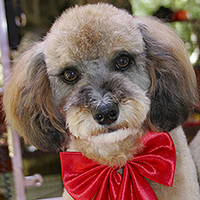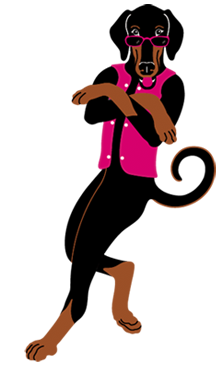‘Oodles: The Hair Truth
by Georgina Covington
5 February 2017
(If you prefer, download this article as a PDF file here)
There is growing concern amongst pet groomers about the promotional language used by some breeders of the “designer dog breeds” known colloquially, collectively as ‘Oodles (e.g. Labradoodles, Spoodles, Cavoodles, Groodles, etc.) which is misleading first-time owners about the grooming requirements of these dogs. As a consequence, the welfare of these animals is suffering, whilst new owners find themselves in for a shock the first time they take their ‘Oodle to be professionally groomed; leaving the groomers in a very difficult position.
So first, let’s talk about hair. All mammals grow hair somewhere on their bodies, if not all over, in the case of most dogs. Hair is the same structure on all of these animals – on people, sheep, platypus, dogs; whether we choose to call it hair, fur, pelt, wool, fleece… it is all in fact the same thing: hair. Each individual hair is a chain of protein molecules strung together, specifically, a protein called keratin. This chain grows in strand-like form from a follicle – or opening – in the skin.
Now, in people, only one hair grows from each follicle. In dogs, up to 27 hairs may grow from each follicle. One of these hairs is coarse and colourful, and is called a primary or guard hair, which in some breeds, like the Poodle, can grow all the way to the ground. The other hairs are fine, soft and pale, and are called secondary or undercoat hairs, and do not grow longer than a few centimetres. If you have ever seen a cashmere goat in Winter, this is the clearest depiction of guard hair versus undercoat hair: long, strikingly coloured, guard hairs poking through masses of soft, fluffy, creamy coloured undercoat hairs. This undercoat is often referred to as “fleece”, but is still, in fact, hair.
Hair, no matter how fine, coarse, straight or curly, has a life cycle. Each strand grows, rests, dies, and eventually falls out, when a new hair grows in its place. This is true of all hairs on all mammals. Any woman with long hair, or any man who has ever unblocked a shower drain, knows this to be true. Relatively speaking, guard hairs have a longer life cycle than undercoat hairs.
Thus, when ‘Oodle breeders claim their dogs are “non-shedding”, this is biologically incorrect. All breeds of dog shed hair. Granted, their pattern of shedding varies – some, like Labradors, shed lots of hair all of the time, because their hairs have a very short life cycle. Some, like Golden Retrievers, shed large amounts of hair twice a year, and only small amounts the rest of the time, because their guard hairs have a long life cycle, but their undercoat hairs, which increase in number during winter, have a short life cycle. Others, like Poodles, who have long lived guard hairs and few or no undercoat hairs, shed very small amounts of hair all of the time.
‘Oodles are created by crossing Poodles, with their long, fast-growing, longer-lived, curly guard hairs and few or no undercoat hairs, with, for example, Labradors, Cocker Spaniels, Golden Retrievers or Cavaliers, with their shorter, coarser, straighter, short-lived guard hairs plus masses of fluffy, even shorter-lived undercoat hairs.
Many ‘Oodle breeders are claiming this creates a wonderful new “fleece” coat which requires only monthly brushing and yearly trimming. Sadly, this is wholly untrue. But first-time owners don’t know this, until they take their new dog to the groomer for the first time, usually when it’s almost 12 months old.
The groomer is then faced with something resembling a sheep left out in the wilderness for the past 5 years. Whilst the top few centimetres of the coat may look terrific to the untrained eye … this is because it is comprised solely of the tips of the ‘Oodle’s longer guard hairs, which the owner has probably been brushing happily every few weeks. Closer to the skin, however, the guard hairs are intermingled with the shorter undercoat hairs, which, due to the non-shedding genetics of the Poodle inheritance, are now not shedding out as easily as they would in a Labrador, but staying put for longer and thus matting tightly together.
You see, when you brush a dog, if the brush doesn’t go all the way to the skin with every stroke, your efforts are completely pointless. Achieving this takes skill and the correct tools – and is impossible to achieve with a long-haired dog if not done at least twice a week. None of these facts are being communicated by ‘Oodle breeder to their puppy buyers.
The saddest part is, these owners love their new dogs. Often they’ve paid handsomely for them, and honestly believed they were looking after them correctly based upon the breeder’s communications. And then, instead of returning proudly from the groomer with their beautiful pet, they leave with something which looks like it’s been waxed from nose to tail, because the matting was so bad and so close to the skin it would be extremely cruel, if not impossible to brush it out, and only the shortest of clipper blades managed to cut underneath it.
What these poor owners – and equally poor dogs – don’t know, is when they leave, the groomer feels just as tearful as they do. Groomers love dogs – but most especially, we love fluffy dogs! We love styling their hair and making them look and feel amazing. We love seeing the joy on their owners’ faces when they come to pick them up. And ‘Oodles, when properly maintained, can be the stars of any grooming salon, with that amazing “big hair” look lending itself to all sorts of fantastic styles like Asian Fusion and more.
Groomers hate shaving dogs. It deprives us of any chance of demonstrating our creativity, the love we have for our job or the skills we’ve worked hard to acquire.
So, on behalf of groomers everywhere, this article is a plea to request ‘Oodle breeders reconsider their approach to the promotion of their dogs: because if all ‘Oodle owners knew their pets needed to be brushed to the skin twice a week and groomed professionally every 6-8 weeks, every grooming salon in the country would be such a much happier place!
Georgina Covington
Biologist, Behaviourist, Veterinary Nurse and Certified Advanced Professional Groomer (and former Wool Classer)

 Asian Fusion
Asian Fusion








